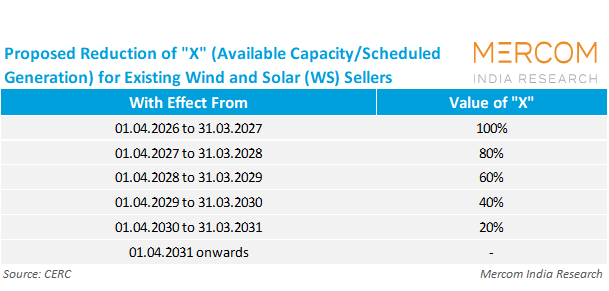CERC Proposes Tightening Grid Deviations by Renewable Energy Projects
The Commission has proposed a reduction in the DSM tolerance band
September 17, 2025
Follow Mercom India on WhatsApp for exclusive updates on clean energy news and insights
The Central Electricity Regulatory Commission (CERC) has proposed tightening the deviation settlement mechanism (DSM) rules for wind, solar, and hybrid projects, effective from 2026.
In a bid to enhance grid stability, it has proposed changing the calculation of deviation settlement to use the project’s scheduled generation instead of available capacity.
The DSM for wind and solar projects from April 1, 2026 will be calculated as follows:
Dws% = 100 x [(Actual Injection in MWh) – (Scheduled generation in MWh)] /
[(X% of Available Capacity) + (100-X) % of Scheduled Generation)
The Commission suggested a phased reduction in the ‘x’ value used in the formula to calculate the deviation in a time block for wind and solar projects.
A reduction in the x value will likely increase the deviation settlement charges paid by wind and solar projects injecting into the grid over time.
The Commission has proposed the reduction in the value of ‘x’ from 100% in 2026 to 0% in 2031.
The Commission has invited stakeholder comments and suggestions by October 5, 2025.
The move also reduces the DSM tolerance band for wind from ±15 % to ±10 %, and for solar from ±10 % to ±5 %.
To understand the impact of the change in DSM calculations, Grid-India conducted a study spanning 16 solar, wind, and hybrid projects over 41 weeks.
The study showed that under the earlier DSM tolerance band, deviation was not seen for 74% to 84% of the time for solar projects, and for 73% to 93% of the time for wind projects.
However, under the new DSM tolerance band, the percentage of time the deviation remains within the respective bands shrank to between 45% and 58% for solar projects, 32% and 73% for wind projects, and 38% and 47% for hybrid projects.
However, under the new DSM tolerance band, solar projects experienced a moderate range of revenue loss, varying from around 3.5% to 11.1%. Hybrid projects showed a slightly wider loss range from 2.4% to 11.8%.
However, the highest impact was seen in wind power projects, where the loss is from 2.8% to 48.2%, reflecting their higher variability and forecasting challenges.
In another study involving a 250 MW wind project, it was observed that the revenue impact due to the DSM charges could be reduced by aggregating multiple projects. By combining the schedules and actual injections of various renewable energy projects, aggregation helps offset individual generation fluctuations and reduces overall deviation.
The Commission noted that the intermittence of wind and solar energy can be addressed by improving forecasting, scheduling, and operational experience. The tightening of the DSM tolerance band is aimed at enabling discipline and compliance on par with conventional generators.
It will also work on amending the DSM Regulations, 2024, to include all existing wind and solar projects, treating them on par with general sellers, effective April 1, 2031. On the other hand, all new wind and solar projects will be treated on par with general sellers from April 1, 2026.
It also stated that to ensure grid stability, wind and solar projects will not be paid for over-injection when the grid system frequency is at or above 50.05 Hz.
India has been witnessing curtailment of renewable energy projects due to grid instability. Nearly 4 GW of wind-solar energy has been curtailed in Rajasthan since March 2025 due to delays in transmission projects and lower power demand resulting from above-normal rainfall in north India.
